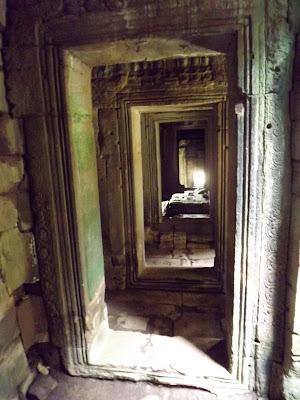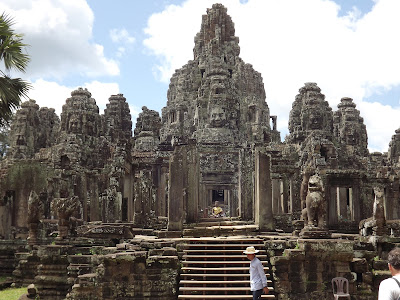November, 2004: As I sat in the back row of tables during study hall my junior year of high school, I caught myself dozing off about 20 minutes into the start of the period. Not wanting to fall asleep, I scanned the back of the classroom for something that would occupy my time and keep me awake. I spotted a cardboard box stacked with dozens of old National Geographic Magazines, piled so high that they were spilling out of the box. I forced myself up and wearily made my way over to them and began scanning the selection: Fighter Planes of WWII, Ancient Amphibians, Eastern Europe After the Fall of the Soviet Union
. After more digging, I found a cover that caught my eye. The title read The Temples of Angkor,
and the cover photo was similar to the one below:

I took this magazine back to my seat and went straight to the cover story. As the clock on the wall ticked, I found myself reading faster in order to take in as much information as possible. I read about how there existed in Cambodia a massive site of ancient ruins in the jungle that was built between the 10th and 13th centuries. The city where these ruins were located, Angkor, was the largest known pre-industrial city in the world, with speculation that it held up to 1 million inhabitants at its peak. The temples contained extremely detailed carvings that related stories from both the Hindu and Buddhist religions. The article went on to describe various other things about Angkor: the giant moats that surrounded the largest temple (Angkor Wat), the bullet holes in the walls that gave indication of the recent violence in Cambodia, the massive trees that have grown around the temples giving them an eerie presence, and the various animals that can be seen wandering around the complex (elephants and monkeys).
By the time the bell rang to signal the end of class, I was hooked. My fascination with Southeast Asia began in that study hall. I found myself snapped out of a kind of daze, and in that moment I looked up and made a promise to myself that I would see the ruins of Angkor with my own eyes.
September 3, 2011: Nearly 7 years after I first read about Angkor in the National Geographic in my study hall, I found myself in a large van heading down a dirty road surrounded by trees in the jungle of Cambodia. As we neared the ruins, yet while they were still out of sight, I was hit by a wave of realization...
This is it... I'm about to accomplish a goal I set for myself when I was 17 years old. My stomach was in knots, and I found myself strangely nervous. We rounded the corner and saw the massive swimming pools that the king had ordered to be built in front of Angkor Wat. I scanned the horizon back and forth, and finally caught glimpse of it in the distance: Angkor Wat, the best preserved temple in the site.
I made it.
There's really only so much that I can say about Angkor. I've never been to Machu Picchu in Peru, the Pyramids of Egypt, the Taj Mahal in India, or the Ancient City of Petra in Jordan, but I imagine Angkor is similar to those places in that its beauty can only fully be appreciated in person. I really like this description of Angkor Wat from Henri Mouhot, a French explorer in the 1800's:
"One of these temples-a rival to that of Solomon, and erected by some ancient Michelangelo-might take an honourable place beside our most beautiful buildings. It is grander than anything left to us by Greece or Rome"
I took over 250 photos while at the ruins, so I'll try my best to considerably shrink the amount of pictures I post to this blog. Enjoy!
 |
| Don't mess with them- they've been guarding this road for about a millennium. |
 |
| There were multiple hallways like this that gave the illusion you were looking at two mirrors facing each other. |
 |
| I saw no signs saying I wasn't allowed to explore! |








































